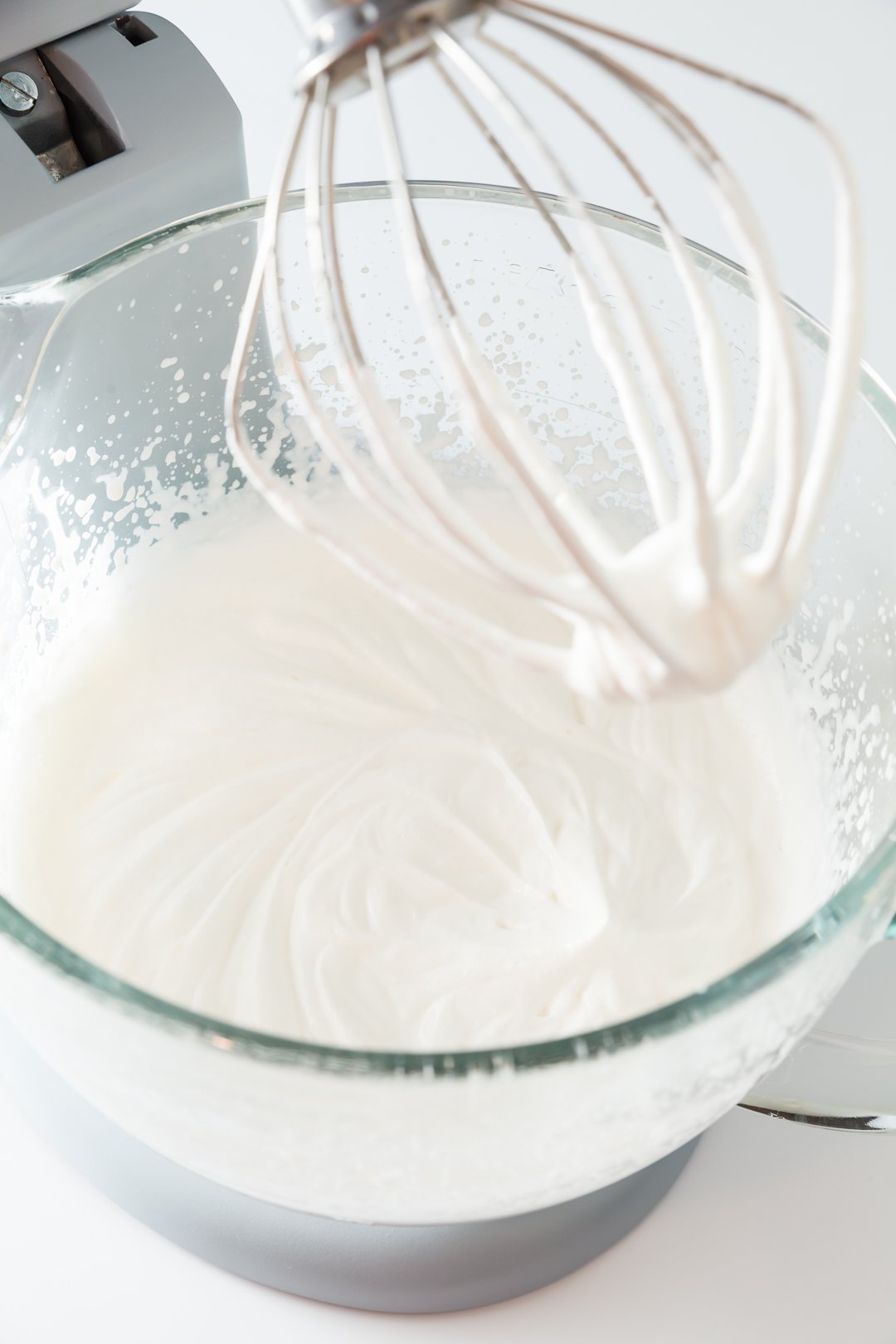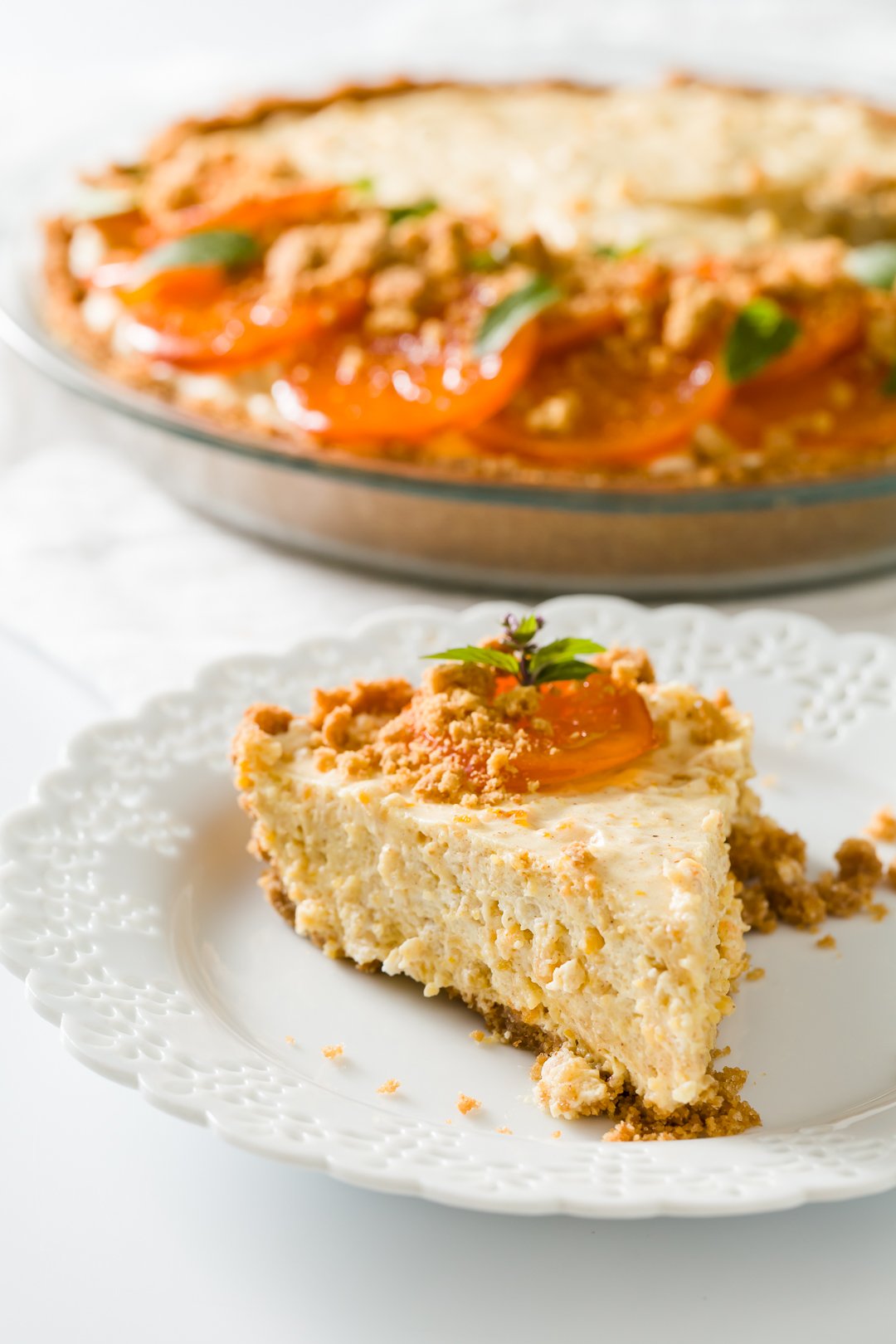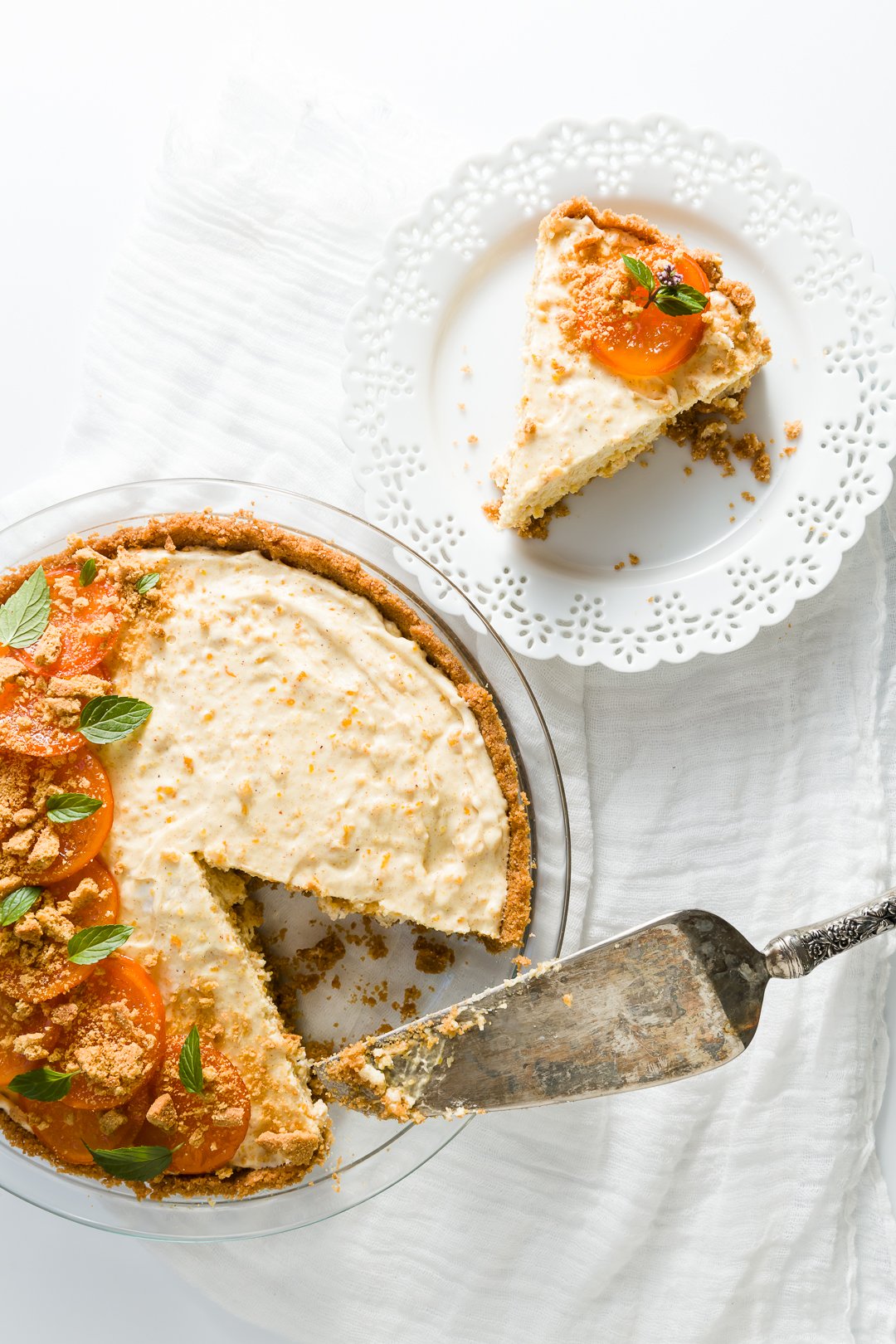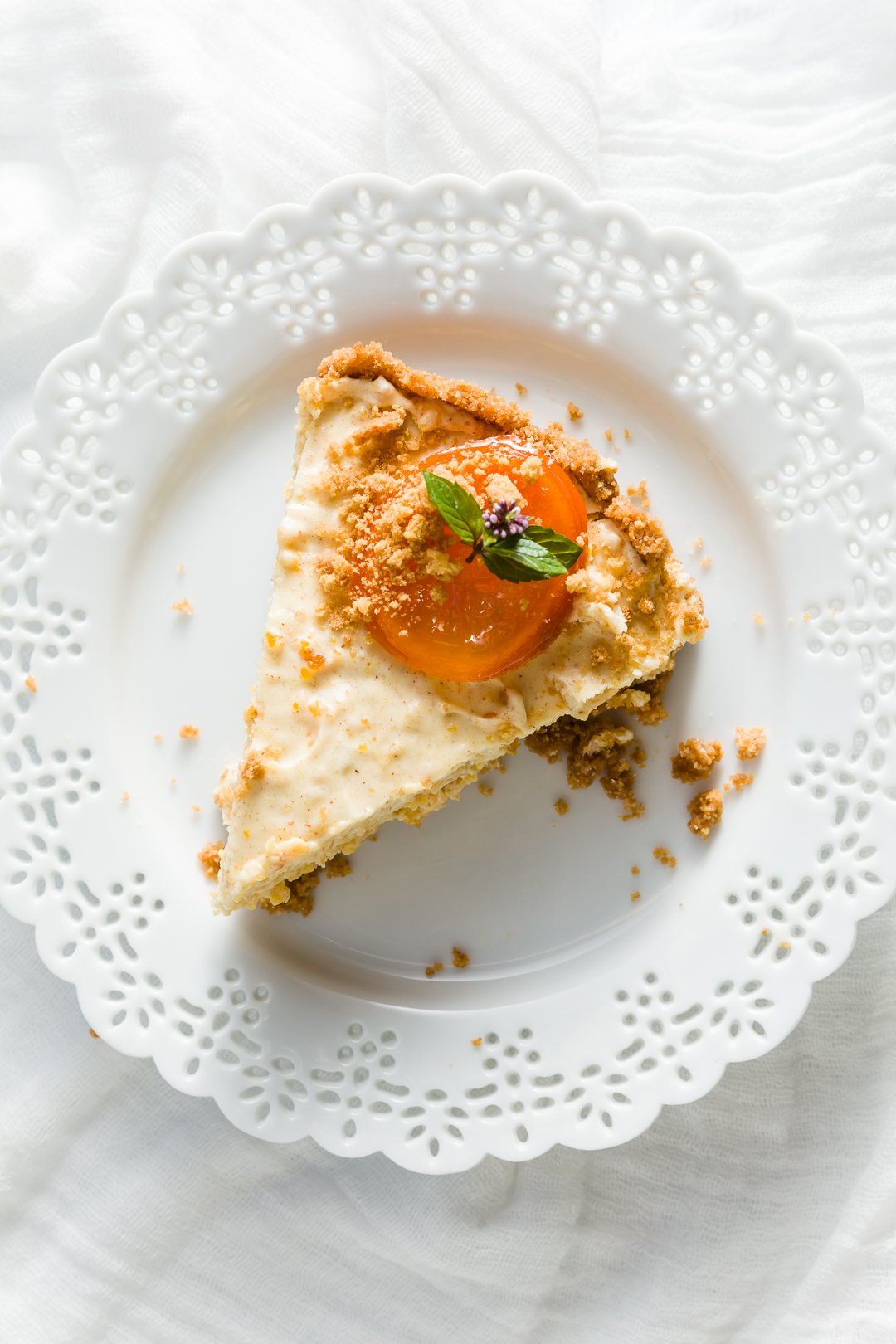Orange Pie Recipe
Orange pie has a fresh, bright flavor and a lovely gingersnap crust. Contributor Jessica Touchette makes hers as a light, fluffy chiffon pie and adds some winter spices.

If you’re looking to up your pie game this holiday season, this orange pie is the way to go. The unbaked filling consists of a flavored egg yolk and gelatin base that thickens the pie the way cornstarch does in a cream pie.
Meringue or cream lightens and supports the flavored mixture, turning what would otherwise be a thick custard into a light and silky confection.
How to Make Orange Pie
To begin, you’ll need to use a double boiler. This lets you gently warm and mix the egg yolks into the other ingredients without actually cooking them.
Make a double boiler by setting a metal mixing bowl over a saucepan of water on medium-low heat.
In the bowl of the double boiler, combine sugar, orange juice, egg yolks, and unflavored gelatin, stirring until thick. The gelatin thickens the orange pie like it does in a mousse cake, but don’t worry – it won’t end up with the consistency of JELLO, like a mirror glaze.
Remove from the heat and add orange zest, vanilla, and spices.
Chill the mixture in the refrigerator until it is thick enough to form small mounds when dropped from a spoon. Start checking at around ten minutes and keep a close eye on it after that point. As you can imagine, it’s next to impossible to fold an airy cream (or meringue) through a solid, gelatinous mixture and end up with a homogeneous filling.
Meringue vs. Whipped Cream
Now, it’s time to lighten up the filling.
Chiffon pie experienced a brief dip in popularity in the 1980s when raw eggs were first associated with salmonella poisoning. However, bakers and food manufacturers soon found a way around this problem, substituting whipped cream for beaten egg whites in the pie’s unbaked filling.
Today, chiffon pie might be made with meringue, cream, or a mix of the two.
I use the cream method.
In a separate bowl or the bowl of a stand mixer, whisk 1 cup of heavy whipping cream with sugar until is looks like whipped cream. You are essentially making a chantilly cream (sweetened whipped cream).

Fold cream lightly through orange mixture until just combined.
Pour pie filling into crust and allow to set fully in the refrigerator.

(While I used cream, you can make your pie more authentic by using 1 cup of egg whites combined with 1/2 teaspoon of cream of tartar rather than the cream. Whisk the egg white mixture until soft peaks form, then gradually beat in the sugar to get stiff peaks.)
Which Pie Crust to Use with Orange Pie
I used a gingersnap crust for this pie. However, a classic pie crust, crust made from Oreo cookies, or even a pretzel pie crust will work, so you needn’t feel wedded to the gingersnap crust.

Buy gingersnap cookies or make your own to use in the crust.
History of Chiffon Pie

I love orange chiffon pie, but nearly any pie flavor, from strawberry rhubarb to pumpkin, can be reinterpreted as chiffon.
Chiffon pie was developed by Californian Monroe Boston Strause in the 1920s.
The teenaged Strause was working as a baker’s apprentice when he set out to improve upon the popular, cornstarch-thickened cream pies that he found to be manifestly unappealing. According to a 1945 article written by Clementine Paddleford for the Los Angeles Times, he turned to an éclair’s cream filling for inspiration.
The cream was made from sugar syrup beaten into stiff egg whites, which was then folded through a flavored cornstarch filling. Strause began to play around with using additional egg whites for lightness and dropping the cornstarch in favor of a tasteless, new-fangled setting agent: gelatin.
The result was what Paddleford called a “filling ethereal,” which Strause’s mother said looked “like a pile of chiffon.”

Strause’s chiffon pie was not a revolutionary invention, for it grew out of the gelatin and soufflé pies featured in cookbooks of the early 1920s. Nevertheless, both Strause and his chiffon pie catapulted into fame.
Strause made a career out of pie baking, lauded at times as both a “pie engineer” (don’t you wish that had been on your kindergarten radar?) and the “Pie King.”
Recipes for chiffon pie began to crop up in cookbooks and women’s periodicals as early as 1929 when a recipe for pumpkin chiffon debuted in the Beverly Hills Women’s Club’s Fashions in Food.
Despite sugar rationing, the pie managed to maintain its popularity throughout WWII. This is a feat widely credited to Irma Rombauer, who printed a recipe for lemon chiffon pie in the 1931 edition of her massively popular Joy of Cooking, and included a whole section on chiffon in subsequent editions.
If you are interested in learning more about chiffon, check out my post on chiffon cake and the differences between chiffon cake and angel food cake.
How to Decorate Orange Pie
I decorated this pie with candied orange slices, crushed gingersnaps, and fresh mint. You could also top it with whipped cream (or even chocolate whipped cream) and call it a day.
Orange Pie
Ingredients
Gingersnap Crust Ingredients
- 2 cups gingersnap cookies broken into chunks
- 2 tablespoons sugar
- 1/4 cup unsalted butter melted
- 1 teaspoon ground ginger optional
Pie Filling Ingredients
- 1/2 cup sugar
- 1 cup orange juice
- 4 large egg yolks
- 1 packet gelatin
- zest of one orange
- 1 teaspoon vanilla extract
- 1/2 teaspoon cinnamon
- 1/4 teaspoon ground nutmeg
- 1/8 teaspoon ground cloves
- 1 cup heavy whipping cream
- 1/3 cup sugar
Decoration Ingredients
- crushed gingersnap cookies to taste
- candied clementines to taste
- fresh mint to taste
Instructions
Gignersnap Crust Instructions
- Preheat oven to 350 F.
- Blend gingersnap cookies into a coarse crumb in a food processor.
- Add sugar, melted butter, and ginger to the food processor, blending until mixture reaches the consistency of wet sand.
- Press into the bottom and up the sides of a greased 9” pie pan.
- Bake for 10 minutes. Cool completely before filling.
Pie Filling Instructions
- Make a double boiler by setting a metal mixing bowl over a saucepan of water on medium-low heat.
- In the bowl of the double boiler, combine 1/2 cup sugar, orange juice, egg yolks, and gelatin, stirring until thick.
- Add orange zest, vanilla, and spices.
- Chill mixture in the refrigerator until thick enough to form small mounds when dropped from a spoon. Start checking at around ten minutes and keep a close eye on it after. As you can imagine, it’s next to impossible to fold an airy cream (or meringue) through a solid, gelatinous mixture and end up with a homogenous filling.
- In a separate bowl, whisk 1 cup heavy whipping cream with remaining 1/3 cup sugar.
- Fold cream lightly through orange mixture until just combined.
- Pour pie filling into crust and allow to set fully in the refrigerator.
Decorating Instructions
- To serve, decorate with candied clementines, crushed gingersnaps, and fresh mint.


Loading comments...